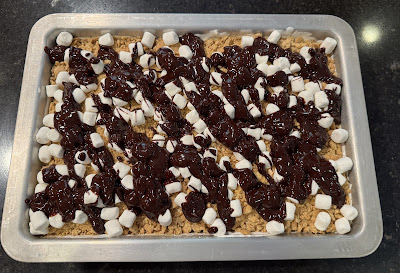Here are some good summer dessert options for groups.
Lemon Refrigerator Cake
1 pkg lemon cake mix
1 3 oz box lemon Jell-O
3/4 c boiling water
3/4 c lemon-lime soda (or substitute water)
1 3.5 oz box lemon instant pudding mix
1 1/2 c milk
1 c whipping cream, whipped
Prepare and bake cake according to directions in a 9x13 pan. Dissolve Jell-O in hot water. Gently stir in lemon-lime soda (or water). Chill in refrigerator while the cake is baking. While baked cake is hot, poke holes in it with a fork and spoon cool gelatin over cake. Refrigerate. Beat pudding mix with milk until thick, fold in whipped cream and spread over top of cake. Chill.
Chessman Banana Pudding
S'mores Poke Cake
Chocolate Peanut Butter Dream Bars
Biscoff White Chocolate Dream Bars
This makes a 9x9 pan. You can buy biscoff cookies and the cookie butter at Trader Joe's.
Oreo Pudding Poke Cake
1 box chocolate cake mix (oil, water, and eggs)
2 boxes Oreo pudding
4 cups milk
1 package crushed Oreos
Reese's Peanut Butter Poke Cake
1 box chocolate cake mix, plus eggs, oil, and water as directed on the box
8 ounces cream
cheese, room temperature
14 ounces
sweetened condensed milk
1 cup creamy peanut butter
12 ounces cool
whip, divided
12 ounces hot
fudge, divided
8 reese's peanut
butter cups, crumbled
Prepare and bake your chocolate cake following instructions on the cake mix box. When the cake is done cooking, poke it all over with a fork. Microwave hot fudge and pour ¾ of the jar on top of the cake so it will soak in.
Beat cream cheese and sweetened condensed milk until smooth. Add peanut butter and continue mixing until thoroughly incorporated. Add half of the cool whip and continue mixing it until smooth. Spread peanut butter mixture evenly over cooled cake. Cover and refrigerate until cool.
Spread remaining
cool whip over peanut butter mixture. Drizzle rest of hot fudge over top. Then
sprinkle the crumbled reese's peanut butter cups over top. Store in the fridge
until ready to serve.






